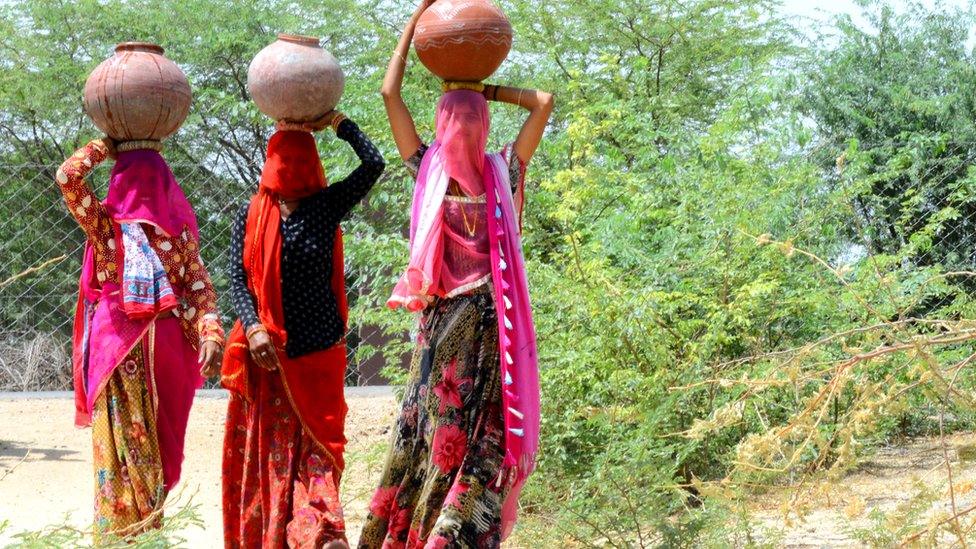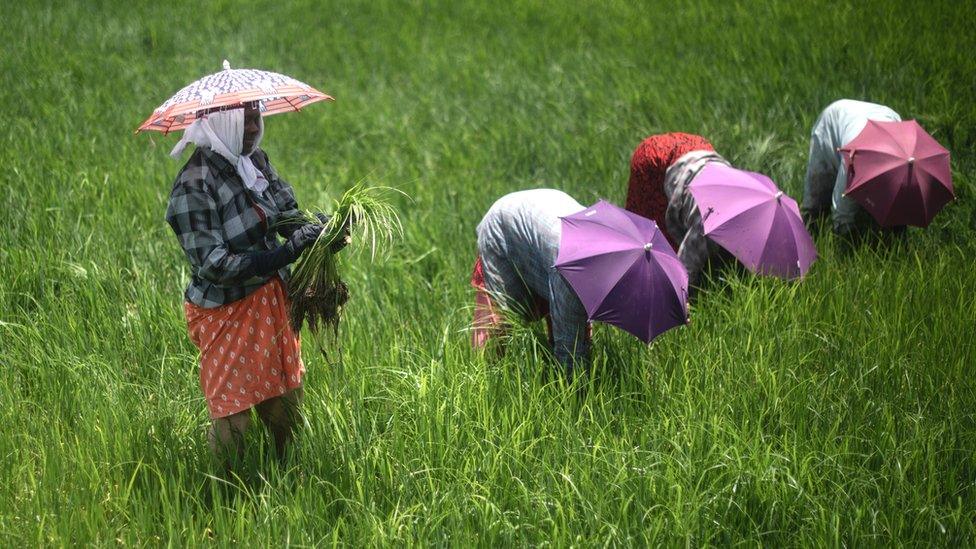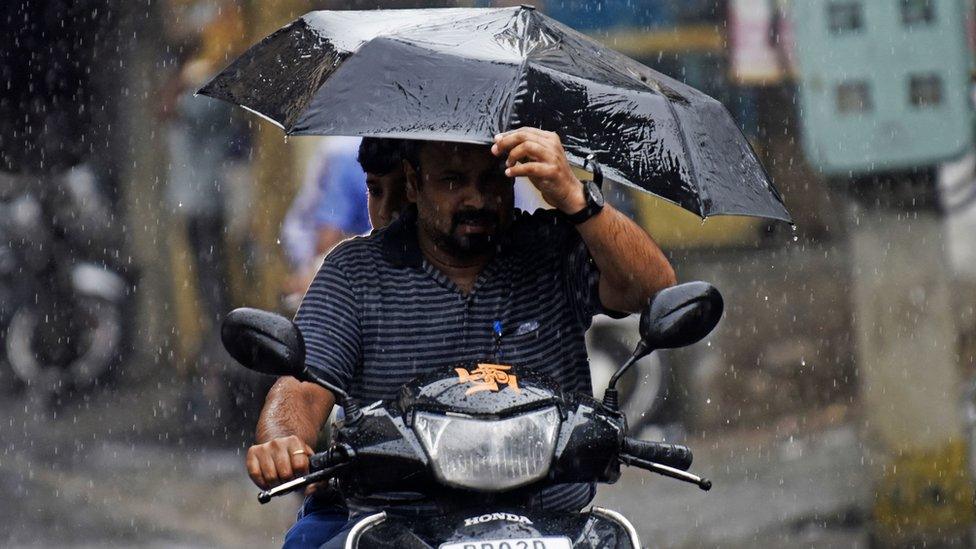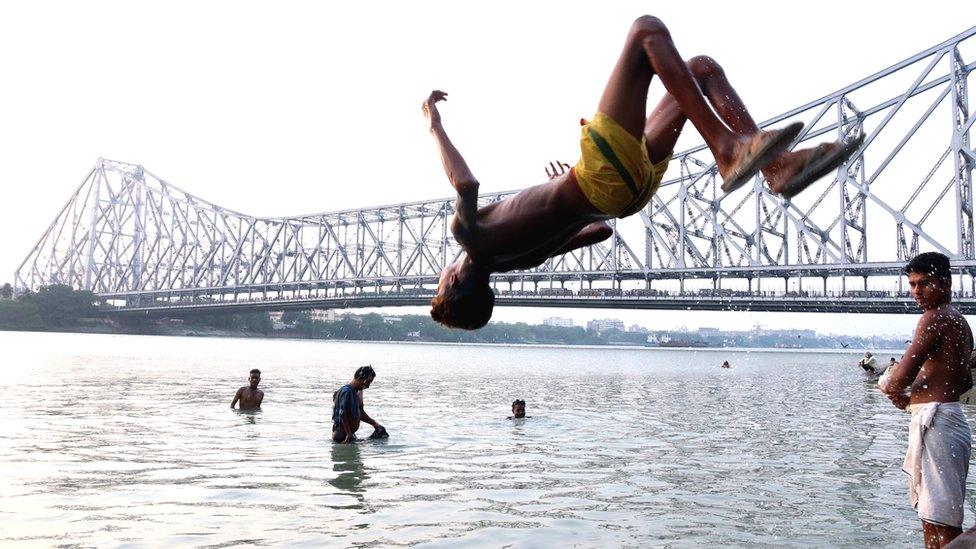High and low-tech ways to tackle India's water crisis
- Published

It's a four-hour round trip for Chaya to collect water
Chaya Badushi lives in the village of Kerawadi, 120 miles (190km) from the bustling streets of India's financial capital Mumbai, but in terms of lifestyle - a different world.
With other women from the village Chaya makes a four-hour round trip to collect water from a river. That task is done twice a day, once at 06:00 and again at 15:00.
"In summers the heat is so bad that many of us have fainted while getting water," she says.
"I have a constant headache, backache, my hands hurt because of carrying water. It's worse for senior citizens like my mother-in-law, who is more than 60 years and has to struggle with me to get water."
The exhausting task has a knock-on effect for the local community. Young women are increasingly reluctant to spend their lives hauling water, so prefer not to marry men from the village. That leaves many men struggling to find a wife.
"There are so many men in our village who are not getting wives just because of basic necessity water," Chaya says.

Collecting water is still a daily task for many women in rural India
Her story is common in rural India. Despite recent improvements, around half of rural households still lack a tap water connection, according to government figures, external.
Water is not only a problem for households. Making sure there is enough water for farming and industry is also a massive challenge.
India has around 17% of the world's population, but just 4% of the world's freshwater resources, according to official reports., external
That makes it one of the most water-stressed countries on the planet and raises questions over the future of food production.
About 74% of the area under wheat cultivation and 65% of the area under rice cultivation faces significant levels of water scarcity by 2030, according to a 2019 report, external from the public policy think tank NITI Aayog.

Much of India's area under rice cultivation will face water scarcity by 2030
Planning India's water budget is made difficult by the monsoon. Around 80% of the annual rainfall falls between June and September, and during those months the heaviest rain lasts for about 25 days.
That means around a seventh of the country is prone to flooding during the most intense periods of rain.
"The problem of water scarcity in India is mostly associated with improper management of the available resources," says Avinash Mishra, who advises the think tank NITI Aayog on water issues.
"We use and discharge untreated water in open channels and freshwater bodies, leading to the pollution of freshwater," he says.
Reserves of water underground, known as groundwater, are also being over-exploited.
"Many regions in Punjab, Haryana, Delhi, Rajasthan and Karnataka abstract more water than their annual replenishment," says Mr Mishra.

Around 80% of India's annual rainfall falls between June and September
One way to tackle the problem is at the national level, with better data.
The Ministry of Jal Shakti, the government department that oversees water resources, has been working with the World Bank on National Hydrology Projects (NHP).
There have been two of these national schemes since the mid-1990s and the government is now in the middle of the third, due to be completed in March 2024.
The first two projects were an attempt to install measuring systems and bring together data about India's water resources. But according to Subhod Yadav, joint secretary of the Jal Shakti Board, the projects had their limitations.
He says much of the data had to be collected by individuals and then fed into the system manually. Meanwhile that data was not available to everyone, and instead was analysed by individual government departments and was also not presented in a useful way.
The latest hydrology project is an attempt to remedy those weaknesses.

India's latest hydrology project will generate real-time data from rivers, reservoirs and lakes all over the country
Around 6,000 sensors are being installed across India to gather data on lakes, reservoirs and rivers. Another 1,600 sensors will track underground water. All will be connected to the mobile phone network and will transmit real-time data, including water levels and weather conditions such as rainfall, humidity and air pressure.
That data will be available on one centralised, web-based system so anyone can use it. Meanwhile software is being developed that can analyse that data and make it useful to decision makers.
"NHP is... moving away from the current system of decision making based on experience and judgements," says Mr Yadav.
"Improved water management is being attempted through the introduction of informed decision making, relying on a host of modern analytical tools and loads of data from automated sensors on each component of the water cycle in real-time or near real-time," he says.
As well as these technology-driven national projects, much is being done at the local level to collect and preserve water.
Megha Dombe from Pachvad village, Maharashtra, used to spend six hours a day fetching enough water for her family.
"Rainfall in this area is uneven, uncertain and irregular. The worst was being a child mother. It was a nightmare," she says.
But two years ago, along with other local women, she began to work with Coro India, a charity that promotes equality for India's most marginalised communities.
Together they pushed a range of initiatives.


A committee was formed to study water scarcity. Villagers were taught to harvest rainwater and use more efficient irrigation systems for their crops.
Grants were secured from the local government for water projects.
"Such things required the support of local men and youngsters. We had a tedious job of convincing them. The process itself took us months," she says.
But the work paid off. "What was once a water-scarce village now has sufficient water," says Megha.
Marcella D'Souza from the Watershed Organisation Trust says such local projects are the key to managing India's water resources.
"The water situation is complex and no single agency can handle it alone," she says.
"It is the responsibility of the local community and gram panchayats [village councils] to share the resources, to work together to protect their precious water resource. They need to be empowered with knowledge so as to make informed decisions."